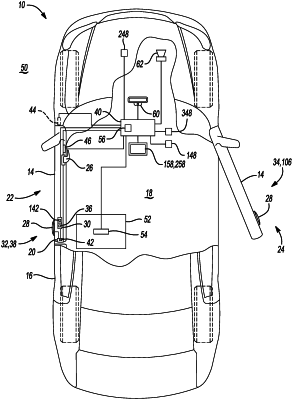| CPC E05B 81/76 (2013.01) [B60R 25/20 (2013.01); E05B 77/24 (2013.01); E05B 77/287 (2013.01); E05B 77/32 (2013.01); E05B 81/72 (2013.01); E05B 85/12 (2013.01); B60R 25/1004 (2013.01); Y10S 292/23 (2013.01); Y10T 292/1047 (2015.04)] | 20 Claims |

|
1. A method of deactivating a secondary lock feature of a vehicle, the method comprising:
sensing a movement of an interior door handle of the vehicle with a sensing device;
determining a status of the secondary lock feature with a secondary lock switch to ascertain if the secondary lock feature is disposed in an active state in which the interior door handle does not open a door;
starting a timer to measure an elapsed time period since the sensing of the movement of the interior door handle;
sensing an environmental condition of an interior passenger compartment defined by the vehicle with a sensor;
setting an unlock delay time based on the environmental condition; and
when the secondary lock feature is disposed in the active state and the elapsed time period is greater than or equal to the unlock delay time, automatically generating a control signal to thereby deactivate the secondary lock feature.
|